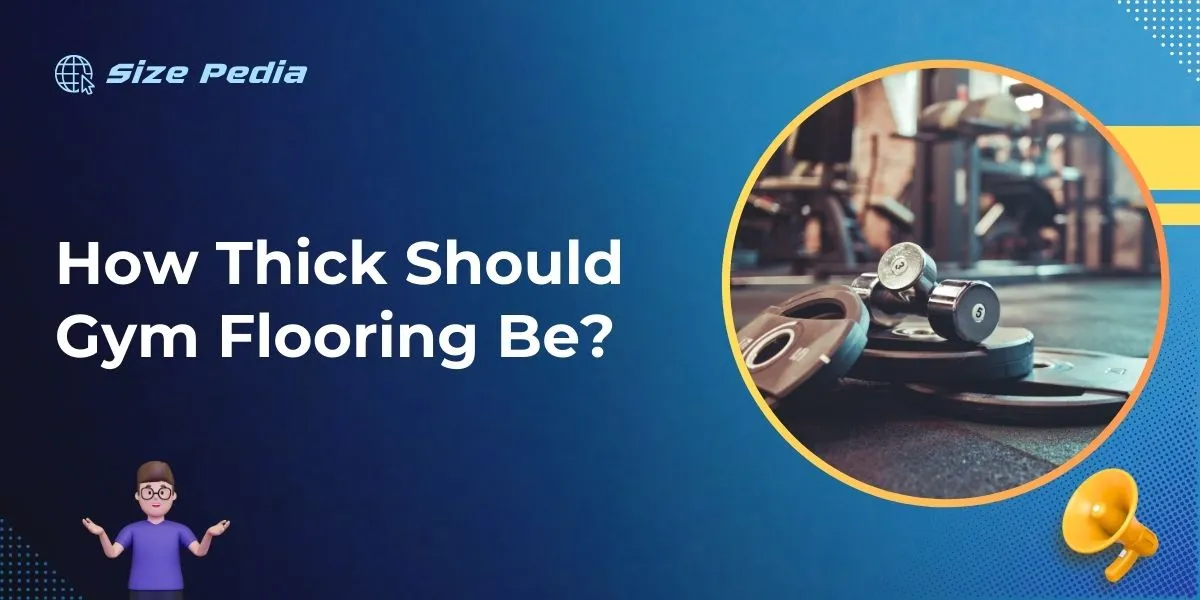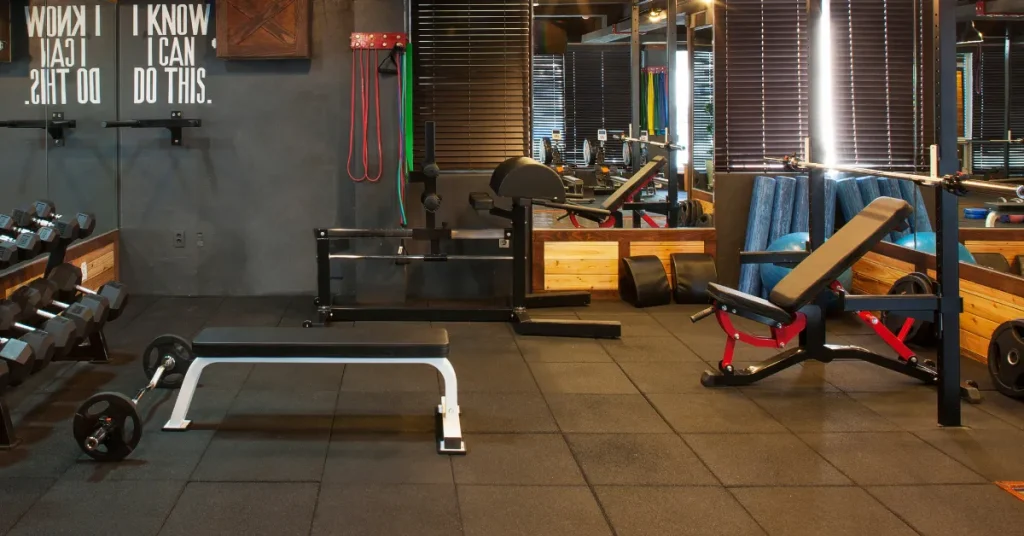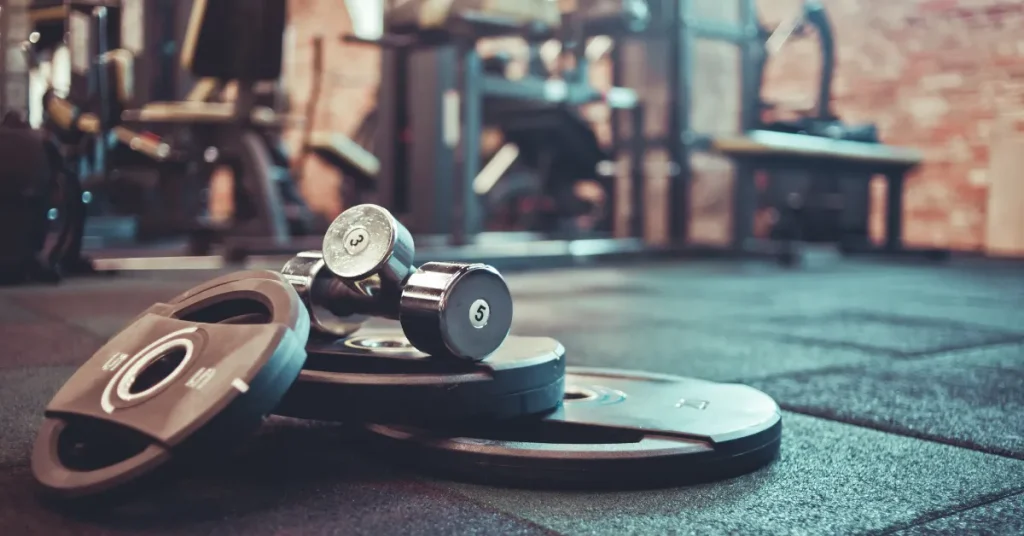Gym flooring typically ranges from 1/4 inch to 3/4 inch in thickness. Optimal thickness depends on the intended exercise activities.
Selecting the right gym flooring is crucial for ensuring safety, comfort, and equipment longevity. Thick flooring, often made of rubber, provides shock absorption that’s essential for high-impact workouts.
It reduces noise and vibration, which is particularly beneficial for facilities located in multi-story buildings.
Conversely, lighter activities might require thinner and less dense flooring options. The thickness of your gym flooring affects not only the feel of your exercise space but also its durability and maintenance needs.
An appropriate choice can enhance the overall performance of your workout environment, while also catering to the aesthetic appeal of the gym.
It’s important to balance your fitness requirements with the material properties to create an optimal fitness area.

The Importance Of Proper Gym Flooring Thickness
Choosing the right gym flooring thickness is crucial. A well-thought-out gym floor shields both equipment and users. It helps athletes perform at their best.
Different activities need different thickness levels. Let’s dive into what makes the thickness of your gym flooring so important.
Safety First: Protecting Equipment And Users
Thick, high-quality flooring absorbs shock. It reduces noise. It prevents injuries. Workout gear lasts longer thanks to the right flooring. Here’s a brief look at the benefits:
- Shock absorption: Protects joints during high-impact activities.
- Noise reduction: Creates a better workout environment.
- Equipment longevity: Less wear and tear on heavy machinery.
Enhancing Performance With The Right Surface
Correct gym flooring thickness boosts performance. It provides a stable base. This enhances power and safety. Athletes can focus on form, not footing. Let’s consider the key performance factors:
- Stability: Offers a firm and level surface for consistent exercises.
- Comfort: Reduces fatigue, allowing for longer and more effective workouts.
- Confidence: Athletes can push limits knowing they have a safe surface beneath them.
Types Of Gym Flooring Materials
When choosing the right gym flooring, knowing the materials is vital.
Gym floors need to withstand heavy traffic, absorb shocks, and provide comfort. The key to this is selecting the right thickness and material.
Rubber, Foam, And Vinyl: Pros And Cons
Rubber
- Durable: withstands heavy equipment.
- Shock Absorption: great for high-impact activities.
- Price: can be costly but a long-term investment.
Foam
- Lightweight: easy to install and move around.
- Comfort: soft surface, gentle on joints.
- Less Durable: not ideal for heavy equipment.
Vinyl
| Pros | Cons |
| Easy to clean | Less shock absorption |
| Resistant to moisture | Can be slippery when wet |
| Versatile designs | Not as durable as rubber |
Understanding Density And Durability Needs
Density and durability matter for gym flooring. Dense materials like rubber provide stability. They are better for areas with heavy weights. Foam is less dense. It is better for light exercises and home gyms.
Durability ensures the floor lasts long. It also keeps maintenance costs low. Choose materials that can handle your gym’s needs.
Measuring The Ideal Thickness For Different Workouts
Choosing the right gym flooring thickness is key to a safe and effective workout environment. Different exercises require different levels of support and shock absorption.
Let’s explore how thick your gym flooring should be based on your workout needs. This ensures optimal performance and longevity of the flooring.
Weightlifting Zones: Greater Thickness Required
Weightlifting areas demand thicker gym flooring to safeguard the subfloor from heavy weights. This section calls for high-density rubber mats that can absorb shock and reduce noise.
- 8mm to 12mm – Suitable for light dumbbells and low impact exercises.
- ½ inch to ¾ inch – Ideal for Olympic lifting and heavy equipment.
Measurements above ¾ inch offer extra protection for intense weightlifting. This prevents damage to both equipment and the floor beneath.
Cardio And Yoga Areas: Balancing Comfort And Stability
Cardio workouts and yoga practices need a stable yet comfortable surface. This ensures both efficiency in the workout and protection for joints and equipment.
| Workout Type | Recommended Thickness |
| Cardio Machines | ¼ inch to 3/8 inch |
| Yoga or Pilates | ⅛ inch to ¼ inch |
These thicknesses offer a blend of cushion and resilience. They protect floors from sweat and equipment impact while providing a non-slip surface.
Installation And Maintenance Considerations

Installation and Maintenance Considerations are paramount when selecting the thickness of your gym flooring. Properly installed gym floors can withstand rigorous workouts and heavy equipment.
It also requires specific care to extend its lifespan. Let’s delve into the pros and cons of Professional vs. DIY installations and the best practices for Long-term Care.
Professional Vs. Diy: What To Expect
Choosing between professional installation and a DIY approach depends on your skills and budget.
- Professional Installation offers peace of mind with expert fitting, ensuring the floor’s performance and safety.
- DIY Installation can be cost-effective if you are handy and have the right tools. It allows flexibility in scheduling and personal satisfaction.
Professional installation often includes a warranty, while DIY offers learning experience but requires careful preparation.
Long-term Care: Ensuring Flooring Longevity
Maintaining your gym flooring is crucial for its longevity.
| Action | Frequency |
| Clean with recommended products | Daily |
| Inspect for wear and tear | Monthly |
| Repair any minor issues | As needed |
Follow manufacturer guidelines for specific maintenance routines. Regular cleaning and prompt repair of damages are essential.
Cost Analysis: Investing In The Right Flooring
Choosing the perfect gym flooring is not just about the thickness. It’s about investing smartly. Quality flooring can save you money over time. Let’s explore the balance between budget and safety in your gym flooring decision.
Budgeting For Quality And Safety
Gym flooring must be safe and durable. A good budget does not cut corners on quality. Proper flooring prevents injuries and equipment damage. Let’s see what factors affect cost:
- Material: Rubber, foam, and PVC each have different price points.
- Thickness: Thicker mats provide more cushion but cost more.
- Size: Larger areas require more material.
Balance your spending between these aspects to get the best return.
Comparing Long-term Savings Versus Initial Outlay
Initial costs of flooring might seem high. Yet, quality gym flooring leads to long-term savings. Here’s how:
| Investment | Benefit |
| Higher Initial Cost | Less frequent replacements. |
| Durable Material | Lower maintenance costs. |
| Proper Installation | Prevents accidents and liability. |
Choosing the right thickness is also an investment in longevity. Compare the lifespan of different flooring options to understand their value over time.
Common Mistakes To Avoid

Choosing the right gym flooring is crucial for both safety and performance. Many gym owners make simple mistakes when deciding on the thickness of their flooring.
This can lead to damaged equipment, injury, and a less comfortable workout environment. Let’s explore some common pitfalls and how to avoid them.
Underestimating The Impact Of Thickness
One of the biggest errors is not considering the significance of gym floor thickness. A thicker floor often means better shock absorption, which is essential for heavy lifting areas.
Thinner flooring might be okay for light exercises but can be quickly destroyed by heavy weights. Here are the key considerations:
- High-impact workouts require thicker flooring for durability and protection.
- Thicker mats can reduce noise and vibration in weightlifting zones.
- Incorrect thickness can lead to early wear and tear, increasing long-term costs.
Overlooking Subfloor Requirements
The subfloor plays a critical role in the overall performance of gym flooring. Neglecting its qualities can lead to problems:
- The subfloor needs to be level and clean before installing any gym flooring.
- Concrete subfloors might demand a thicker floor to ensure comfort and safety.
- Ignoring moisture levels in the subfloor can lead to flooring damage.
A thorough assessment of the subfloor ensures the selected gym flooring functions as intended. Always consult with a professional to avoid these common flooring mistakes.
FAQs About How Thick Should Gym Flooring Be
What Is The Best Thickness For Gym Floors?
The ideal thickness for gym floors typically ranges from 8mm to 3/4 inch, providing durability and shock absorption.
What Is The Best Thickness For A Workout Mat?
The ideal thickness for a workout mat is about 1/4 inch (6mm). This thickness provides a balance of cushioning and stability for most exercises.
How Thick Should A Concrete Slab Be For A Home Gym?
A concrete slab for a home gym should typically be 4 to 6 inches thick to adequately support heavy equipment and weights.
Is 8mm Rubber Flooring Good For Gym?
Yes, 8mm rubber flooring is suitable for gyms as it provides durable, shock-absorbent surfaces ideal for heavy equipment and intense workouts.
Conclusion
Choosing the ideal gym flooring thickness isn’t one-size-fits-all. It hinges on your gym’s activities and equipment.
A balance between safety and practicality is crucial, typically ranging from 8mm to 30mm. Remember, investing in the right flooring minimizes injury risks and optimizes workout efficiency.
Make your decision count for a durable, functional gym space.
Resources:
1. https://www.fema.gov/appeal/gym-floor-replacement
